- About
- Academics
-
Undergraduate Programs
- Civil and Environmental Engineering
- Architecture and Architectural Engineering
- Mechanical Engineering
- Industrial Engineering
- Energy Resources Engineering
- Nuclear Engineering
- Materials Science and Engineering
- Electrical and Computer Engineering
- Naval Architecture and Ocean Engineering
- Computer Science and Engineering
- Aerospace Engineering
- Chemical and Biological Engineering
-
Graduate Programs
- Civil and Environmental Engineering
- Architecture and Architectural Engineering
- Mechanical Engineering
- Industrial Engineering
- Energy Systems Engineering
- Materials Science and Engineering
- Electrical and Computer Engineering
- Naval Architecture and Ocean Engineering
- Computer Science and Engineering
- Chemical and Biological Engineering
- Aerospace Engineering
- Interdisciplinary Program in Technology, Management, Economics and Policy
- Interdisciplinary Program in Urban Design
- Interdisciplinary Program in Bioengineering
- Interdisciplinary Program in Artificial Intelligence
- Interdisciplinary Program in Intelligent Space and Aerospace Systems
- Chemical Convergence for Energy and Environment Major
- Multiscale Mechanics Design Major
- Hybrid Materials Major
- Double Major Program
- Open Programs
-
Undergraduate Programs
- Research
- Campus Life
- Communication
- Prospective Students
- International Office
A research team led by Professor Byoungho Lee, developed a 3D Augmented Reality (AR) glass
-
Uploaded by
관리자
-
Upload Date
2018.03.02
-
Views
481
A research team led by Professor Byoungho Lee, developed a 3D Augmented Reality (AR) glass
- Overcome limitation of conventional glass type display
- Published in the international journal ‘ACM Transactions on Graphics’
▲ Professor Byoungho Lee (left) and Chanwon Jang (right) of Department of Electrical and Computer Engineering
Seoul National University College of Engineering (Dean, Kookheon Char) announced on 14th that a research team led by Professor Byoungho Lee of Department of Electrical and Computer Engineering developed 3D augmented reality(AR) near-eye display.
Augmented reality glasses or augmented reality near-eye displays are devices that display a virtual image when worn by a user. Recently, the concept of virtual reality (VR) augmented reality (AR) and mixed reality (MR) has been popularized as one of the technologies that will lead the fourth industrial revolution.
As prototypes such as Google's Google Glass and Microsoft's Hololens have become known to the public, it became a fierce field for global and domestic large corporations. The display developed by the research team can provide a 3D image on a real object as an augmented reality (AR). In addition, it is a core technology that can overcome conventional limitation that the size of angle of field and eyebox contradict each other.
The 'angle of field', which determines how big a virtual image can be provided, and the 'eye box', the range in which the eye can be seen to view the image, must sacrifice one to increase the size of either. For this reason, most of the prototypes are very difficult to exceed the angle of filed of 30 degrees.
The professor 's team solved the problem by developing the light field projection technique based on pupil tracking. It measures eye movements in real time and forms an eyebox only at the required position. It increases the size of eyebox without inconvenience and also increases the angle of field up to 60 degrees. The light field can be generated with a small load of calculation, and the size of the system can be reduced by using a thin film type holographic optical element.
Professor Byeong-ho Lee said, "Through this research, we were able to overcome the important obstacles for universalization of augmented reality glasses. In the competition for the fourth industrial revolution, we will be able to prevail core technologies in the field of virtual / augmented reality.”
Meanwhile, the study was published in ‘ACM Transactions of Graphics’, the most prestigious journals in the field of computer graphics.

▲ light field projection technique based on pupil tracking for augmented reality near-eye displays (provided by College of Engineering, Seoul National University)